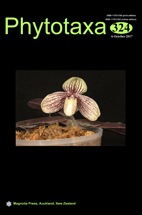Abstract
Considerable uncertainty surrounds the phylogenetic position of Polysiphonia scopulorum, a species with an apparently cosmopolitan distribution. Here we report, for the first time, molecular phylogenetic analyses using plastid rbcL gene sequences and morphological observations of P. scopulorum collected from the type locality, Rottnest Island in Western Australia. Morphological characteristics of the Rottnest Island specimens allowed unequivocal identification, however, the sequence analyses uncovered discrepancies in previous molecular studies that included specimens identified as P. scopulorum from other locations. The phylogenetic evidence clearly revealed that P. scopulorum from Rottnest Island formed a sister clade with P. caespitosa from Spain (JX828149 as P. scopulorum) with moderate support, but that it differed from specimens identified as P. scopulorum from the U.S.A. (AY396039, EU492915). In light of this, we suggest that P. scopulorum be considered an endemic species with a distribution restricted to Australia. Our results showed the existence of several distinct clades among the species of Polysiphonia sensu lato, including the clade containing P. scopulorum which did not join with the generitype Polysiphonia stricta (i.e., Polysiphonia sensu stricto). This suggests that the P. scopulorum clade might represent a separate genus, however, further studies including multi-gene analyses are recommended before recognizing any segregate taxa.

